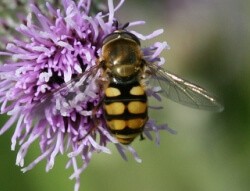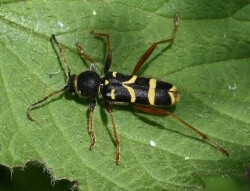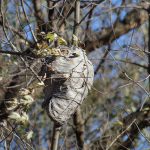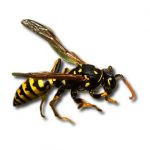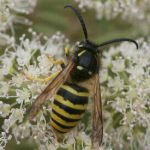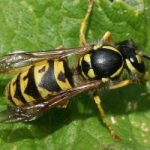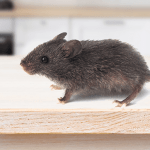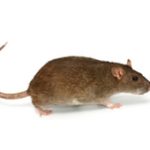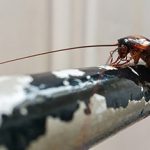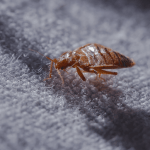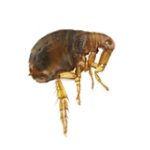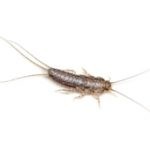British Wasps – Identifying UK Wasp Species
There are hundreds of wasp species all over the world and hundreds more of hornets, bees and other similar-looking insects. All are an important part of the ecosystem, as even wasps are valuable pollinators. You can find a wide variety of wasps across the UK, and not all of them will sting you.
It’s important to understand the difference between wasp species because everything from their nesting habits to how aggressive they are differs. You need this information if you want to get rid of the wasps without getting hurt. So let’s take a closer look at the British wasps.
German wasps
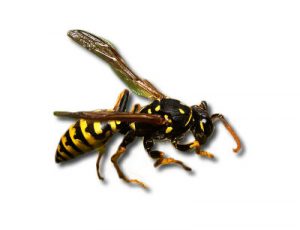
Vespula germanica
Appearance
- Adults are around 13mm in size;
- Typical yellow and black colouring;
- Looks like the common wasp but has three black dots on its face. You can spot similar markings on their abdomen.
General facts
- Also known as German yellowjacket or European wasp;
- Invasive and extremely destructive in nature, these wasps can harm wildlife inside invaded territories;
- German wasps are not great travelers; humans have helped with their distribution around the world;
- You can find most german wasp nests in the ground, in attics and only a small part is above ground;
- Some nests die off in winter because of the cold temperatures. But, if the nest is well protected from bad weather and survives, it will continue to grow the next year;
- German wasps are efficient scavengers. Once they find a food source, they will be able to find it again;
Image by: Juan Emilio
Common wasps
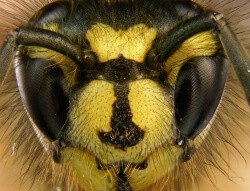
Vespula vulgaris
Appearance
- Adults are about 12 to 17mm in size and the queen can reach up to 20mm;
- They have a typical yellow and black colouring with dots and rings on the abdomen;
- Females and queens look like German wasp but instead of the three dots, the black markings on their faces are anchor- or dagger-like;
- Males are almost identical to the German wasp with differences that can hardly be detected with the naked eye;
General facts
- This species is also known as the European wasp or the common yellow jacket;
- Builds nests inside wall cavities, hollow trees, crevices, and holes but also underground;
- Adaptive and able to live in a wide variety of habitats;
- Uses pheromone trails to navigate to a foraging site;
- Nests are much smaller than the ones made by German wasps and never survive through the winter because of the lack of food.
Image by: Scientific Illustration
Looking for wasp removal service
Get assistance from a wasp specialist!
Call us
Red wasps
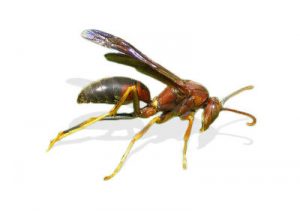
Polistes carolina
Appearance
- Adults of both sexes reach 25 to 32mm in size;
- Reddish-brown in colour with, sometimes, brown stripes on the abdomen. Have distinctive black wings;
General facts
- Also known as red paper wasps;
- These wasps build some of the largest nests. They prefer to build them in well-protected areas;
- They use a paper-like material to build nests that resemble an upside-down umbrella with exposed cells;
- Queens are not the largest but rather the first to start the nest;
- The red wasps feed on caterpillars, nectar, cicadas and some larvae but can form an appetite for man-made sugary foods;
- These wasps are more aggressive than other paper wasps and their stings are more painful.
Image by: David Hill
Norwegian wasps
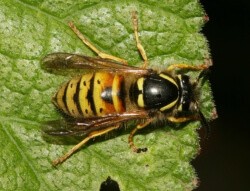
Dolichovespula norwegica
Appearance
- The average length of this species is about 11-18mm, with queens being the largest;
- Has the distinctive for wasps black and yellow colouring but you can also see some red areas on the front of the abdomen;
General facts
- Being a tree wasp, its favourite places for nesting include low branches of trees and shrubs;
- Its diet includes flies, other insects, and spiders for the larvae. Adults feed on nectar obtained from snowberry and blueberry flowers;
- Norwegian wasps prefer to build their nests in rural areas. Favourite spots include house walls, trees, shrubs, and sometimes underground cavities, with a preference to closed-off areas;
- Nests usually die off after mid-August but some can last through the early September.
Image by: S. Rae
Tree wasps
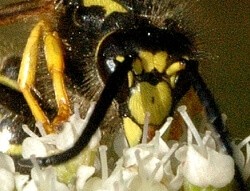
Dolichovespula sylvestris
Appearance
- With an average length of 11-17mm and size of queens up to 15-19mm;
- Has a typical black and yellow body colouring. You can spot a single black dot in the centre of its face;
- This wasp has brownish wings;
General facts
- Builds both aerial and underground nests. The common thing between the nests is that they are all suspended from an overhanging structure, be it a rock, a grass stem or a tree branch;
- These wasps are not considered a pest mainly because human food does not attract them;
- They are far less aggressive than other wasp species but will still attack if you threaten their nest.
Image by: Ecology of Commanster
Saxon wasps
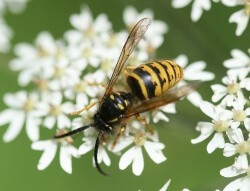
Dolichovespula saxonica
Appearance
- Looks similar to the yellowjacket, with black and yellow stripes, but is larger than other look-alike species;
- With a body length between 11 to 15mm and queens that reach up to 15-19 mm in size;
General facts
- They make their small and ball-shaped nests above the ground, in shrubs and trees, but also in buildings. These wasps usually nest in easy to see locations;
- Saxon wasps are beneficial pollinators and a natural enemy of insect pests;
- Aren’t aggressive but will protect their nest if needed. They release a pheromone that attracts other wasps from the nest and stimulates aggressive behaviour;
- These wasps spread diseases. The nests accumulate waste that can be a source of pathogens such as Escherichia coli, Candida krusei, Klebsiella oxytoca and more.
Image by: S. Rae
Median wasps
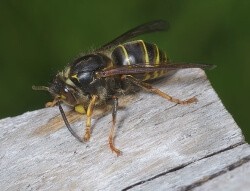
Dolichovespula media
Appearance
- Adult wasps reach up to 16-22mm in length, and people often mistake queens for hornets because of their reddish colour;
- You can recognize the median wasp by its black thorax that has four yellow spots;
General facts
- Builds aerial paper nests, mostly under building eaves, in trees, and shrubs;
- The species prefers humid areas, which is why they build nests out in the open and close to the ground;
- Despite defending their nest, the median wasp is not very aggressive and prefers to fly away rather than attack when disturbed. But it can and will sting if you threaten it;
- It’s attracted to sweet foods and will fly near people eating outside.
Image by: Pjt56 @ Wikipedia
No matter the type, wasps are still dangerous. They are easily annoyed and very protective of their territory. And at times, they will sting even if not provoked. If a wasp has stung you, check our other articles that cover the matter in detail:
Learn more about wasps >
Professional wasp treatment
Book local wasp specialist to help you against the pests!
Call us
Insects that look like wasps
There are many insect species that get mistaken for wasps, so you shouldn’t run at the first sight of black and yellow stripes. Bees and hornets are the most common wasp lookalikes.
But some species of flies, beetles and even ants look very similar to wasps, especially to the uneducated eye. Not all of those wasp-resembling bugs have the wasp’s temper and most don’t even sting.
Impact wasps have on humans and nature
Most people consider wasps to be baddies but they do also play positive roles in the ecosystem. They impact a great range of human activities and affect the ecology in many ways.
- Most solitary wasps, for example, are parasitoidal. How does that matter, you ask? Well, they use insects we deem as agricultural pests (such as whiteflies) as hosts to lay their eggs into. This usually results in the host’s death so this way wasps lower and effectively control the population of many insects that are harmful to crops.
- While not to the extent of bees, some wasps are also effective pollinators. Their means of pollination, however, are slightly different than the bees’. While the latter use their hairy bodies to gather and spread pollen, wasps use the crops of their bodies to store and transport pollen.
Another good example is the fig wasp which is the only pollinator of a wide variety of fig trees. - Wasps are also a widespread pest in human dwellings. Wasp stings are not only painful but can trigger allergic reactions in some people.
- Predatory and parasitoid wasps are an economic pest in industries such as beekeeping and forestry. They destroy beehives, inflicting significant financial loss to beekeepers.
If there’s a wasp nest near your home and you feel threatened by it, feel free to get in touch with us for wasp nest treatment.
Disclaimer
We share useful information based on the education, experience and knowledge of the pest technicians. However, we don’t provide any medical advice.
Read more
